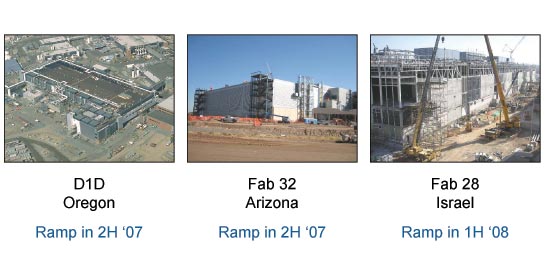Intel Demonstrates new 45nm Transistors and Conroe's Successor
by Anand Lal Shimpi on January 27, 2007 12:00 AM EST- Posted in
- CPUs
Yields and Manufacturing
Intel is sharing its usual vague data on yields at 45nm, but at least this time we get pretty good reference points to previous manufacturing processes. The graph below shows defect density as a function of time; you should keep in mind that processors generally don't start shipping until the very bottom of these curves in order to make the economics work for the CPU maker.

As you can see, 45nm is on a curve very similar to that of Intel's 65nm process, which means that things are on track for a smooth introduction later this year barring any unforeseen issues.
Intel attributed the rough patches in the 90nm trend to difficulty associated with building the first strained silicon transistors and using low-k interconnect dielectrics. By comparison, 65nm and 45nm appear to be much smoother sailing.

By the end of this year the first 45nm chips will be built at two 300mm Intel fabs: D1D in Oregon and Fab 32 in Arizona. Starting in the first half of 2008, Fab 28 in Israel will begin producing 45nm parts and should reach full capacity by the end of the year.
Final Words
It's very rare to get this much information out of Intel this far in advance of an actual product launch, but we're not complaining. By the middle of this year, AMD will launch its next-generation microarchitecture that will hopefully be a far better competitor to Intel's Core 2 processors. But before the year is out, Intel will respond yet again with its Penryn family of processors. We're unsure exactly what segments will be targeted first with Penryn, but by sometime in 2008 you should be able to get Penryn based notebooks, desktops and servers.
The inevitable comparison to AMD's progress on 45nm has to be made, but at this point we don't know too much. AMD revealed its 45nm SRAM test vehicle about three months after Intel did last year, with a slightly larger SRAM cell size (0.370 um^2 vs. 0.346 um^2 for Intel). The main focus for AMD at this point is the transition to 65nm; we're finally starting to see Brisbane cores available for purchase, but the highest clock speed offerings are still built on 90nm.
For Intel, we see continued strengthening and a roadmap that has a lot of promise. Penryn should be out sometime in the second half of this year, followed by a brand new architecture under the codename Nehalem. Nehalem will also be the first time we get to see an architecture change post-Core 2 under Intel's new tick-tock model of introducing new architectures every two years. It's quite possible that in the next two years Intel will have made the CPU industry far more exciting than it has been in the previous five (Core 2 launch withstanding).










59 Comments
View All Comments
Viditor - Tuesday, January 30, 2007 - link
OK...I choose Barcelona!
God I love these macho/nerd games...it takes me bake to my College days of D&D with Tequila shooters! (just be careful with that Intel +5 Vorpal Blade though!)
Huh? The stumbling block for scaling is Intel's platform (FSB)...
verndewd - Sunday, January 28, 2007 - link
lets make it fair and get a 65nm firstgen intel D900 series ,ultimately thats where the real comparison is at.(dont you wish it were that simple? hehehe)unfortunately Thats not the current market due to amd transitioning later than intel.The new york times said 9 months,but the first 65nm intels arrived late in 05.How is that for curious?
archcommus - Saturday, January 27, 2007 - link
Yeah, don't be a fanboy, buy whatever is the best purchase. My area of concern is that if AMD won't be delivering on par with Intel, it allows Intel to charge a price premium UNLIKE this past summer where we were lucky to see fierce price wars. If Intel gets too far ahead it could very well go back to the old days of Intel being the expensive mainstream chip and AMD being the cheaper choice for the DIYer.Regs - Saturday, January 27, 2007 - link
All I see is Intel advancement and AMD's foggy future.SunAngel - Saturday, January 27, 2007 - link
murder by numberssmn198 - Monday, January 29, 2007 - link
Also, the Intel Xeon ad appears on top of the article text. Really need to get my ad removing plug-in installed again.
bombledmonk - Monday, January 29, 2007 - link
it's 100mm^2, not 100mmx100mm. same for the 50mm^2bombledmonk - Monday, January 29, 2007 - link
whoops, wrong quote, and it had been answered below...shaunmarsh - Saturday, July 28, 2012 - link
This article is very good & informative.I have gain so much information from this blog.I like your blog.Thanks for the post.I am waiting for your new post.